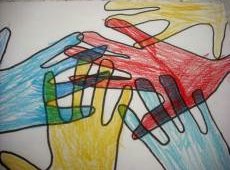Guest Editorial: Interconnecting and Friendship’s Bonds
by Tom Gibian

Sandy Spring School, 2nd Grade Art Work; courtesy grover.ssfs.org/~ksantori/art/2nd_grade.htm
One of the underlying principles of Gandhi’s philosophy of nonviolence is our capacity for interconnectedness, or as Gandhi was to state it, “the interconnectedness of all beings.” Interconnectedness, or connecting, is also very much at the heart of Quaker concerns.
I remember being in third grade and having to line up and pair off with a classmate to walk down the hallway to some destination beyond our classroom. At Sherwood elementary school, there might have been 29 or 30 nine-year-olds and one teacher. On the day I’m recalling, I was paired off with a kid named Sammy. I was new at Sherwood and someone warned me that Sammy had sweaty palms. As we headed down the hallway, he took my hand. His hand was sweaty, but it didn’t matter. We held hands without embarrassment. We were not self-conscious. We were little, at least relative to the world we were living in, and it could not have been more natural to reach out, to partner, to connect. Later, Sam would be one of the first friends of mine to get a high-performance muscle car in high school. That is a different story!
Now, when I see the little kids walking to lunch, or to the playground, or to meeting for worship, or to gym class, — basically whenever I see them and wherever they’re going — they’re holding one another’s hands. Practically snuggling. And happy; they are really, really happy.
It reminds me that all through life, and certainly as adults, we are seeking the comfort and satisfaction and safety and pleasure that comes when we connect with one another. Connectedness is built on a platform of trust, of mutual respect, of a certain sense of shared awareness. Sometimes there is a physical element to connectedness and sometimes not. We connect through music, we connect through silence, we connect through literature, we connect on the court and the pitch, in the lab and on the bus. We connect when we’re together and, sometimes, the most profound sense of connectedness comes when we’re apart. We connect with those we like, when the conditions are right, when the stars are lined up, when we open our hearts, when we get lucky, when the timing is right, when we least expect it, and when we most need it. I think of being connected as something that is open to us when we’re open to it.
I’m told that there are urban transit systems where an underground cable runs constantly; to move the train forward, the conductor pulls a lever and a mechanism grabs the moving cable; a nice metaphor. What connects us is always moving, just below the surface. It is up to us to reach out, to grasp it and to hold on. The same cable George Fox recognized when he told Friends to “walk cheerfully over the world answering that of God in everyone.”
EDITOR’S NOTE: Tom Gibian is the Head of the Quaker-heritage prep school (preK through 12), Sandy Spring Friends School in Sandy Spring, Maryland. He was chief executive officer, managing director, and founding partner of Emerging Capital Partners, the largest fund manager working in the African continent and was also Executive Director for the Asia-Pacific Region of Goldman Sachs (Asia) Limited (1992-1995). He has his own blog, at: wordpress.ssfs.org/?cat=3.




